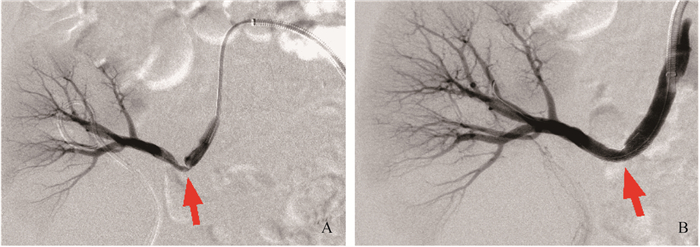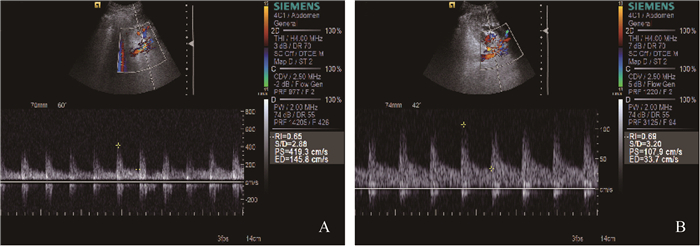2. 复旦大学超声医学与工程研究所 上海 200032;
3. 上海市器官移植重点实验室 上海 200032
2. Institute of Ultrasound Medicine and Engineering, Fudan University, Shanghai 200032, China;
3. Shanghai Key Laboratory of Organ Transplantation, Shanghai 200032, China
肾移植作为终末期肾病最理想的治疗方法,可延长患者生存时间,提高患者生活质量[1]。自1954年首次成功移植人类肾脏以来[2],肾移植已广泛应用于临床。肾移植术后容易发生各种并发症,近年来随着围手术期的处理、手术技术的标准化及免疫抑制剂的使用,术后排斥反应发生率有所下降,肾移植患者生存率有极大的改善,但血管并发症仍是肾移植术后的巨大挑战,可导致移植肾功能下降甚至患者死亡[3]。其中移植肾动脉狭窄(transplant renal artery stenosis,TRAS)最为常见,至少占肾移植术后血管并发症的75%[4]。TRAS的主要临床表现为肾功能下降以及难治性肾血管性高血压,在狭窄严重的患者中,甚至会出现由于移植肾血供严重不足而引起移植肾衰竭的情况。TRAS患者尽早进行血管介入治疗可以延缓甚至逆转部分肾功能损害,因此早期准确诊断并及时治疗对TRAS患者预后至关重要。关于TRAS的治疗,有研究认为影像学检查提示患有严重TRAS的患者才考虑行介入治疗[5],一些轻中度狭窄的TRAS患者肾功能趋于稳定,甚至可能自行恢复。因此,在进行血管造影及介入治疗前,区分狭窄程度具有重要的临床意义。彩色多普勒超声作为一种经济、无创的检查,在诊断TRAS方面具有较大的临床应用价值[6]。有研究表明[7],在彩色多普勒超声作为肾移植术后常规筛查手段前,TRAS的检出率仅为2.4%,而将彩色多普勒超声作为肾移植术后常规筛查手段之后,TRAS的检出率上升至12.4%,术后常规行彩色多普勒超声筛查有助于早期发现TRAS。我们的前期研究已证实彩色多普勒超声可作为TRAS的筛查方法[8],为进一步探究彩色多普勒超声在TRAS早期诊断、狭窄程度评估以及介入治疗效果评价中的临床应用价值,本研究选取经DSA或MRA确诊为TRAS的患者作为研究对象,现报道如下。
资料和方法研究对象 回顾性分析2013年2月至2020年5月复旦大学附属中山医院收治的肾移植术后患者的临床信息、彩色多普勒超声检查结果及穿刺病理结果,其中因移植肾功能异常行彩色多普勒超声检查发现主肾动脉流速增高,穿刺病理排除排异反应后,被临床疑诊为TRAS的患者31例,所有疑诊患者均先行彩色多普勒超声检查,再行数字减影血管造影(digital substraction angiography,DSA)或磁共振血管造影(magnetic resonance angiography,MRA),最终27例患者被确诊为TRAS,纳入狭窄组。根据DSA或MRA显示的内径减少率,狭窄程度50%~79%为中度狭窄(n=6),狭窄程度80%~99%为重度狭窄(n=21)。另选取本院同期行肾移植且术后移植肾功能稳定(术后随访6个月内临床表现、化验结果及超声检查结果均无异常)的患者48例作为对照组。
本研究经复旦大学附属中山医院伦理委员会批准(批件号:B2021-224R2)。纳入标准:(1)经DSA或MRA明确诊断为TRAS;(2)确诊前在我院曾行一次及以上彩色多普勒超声检查,且声像图资料保存完整。排除标准:(1)合并移植肾肾周积液、移植肾尿路梗阻、移植肾急慢性排斥反应;(2)合并局部感染、心肝肾脏器功能明显异常;(3)超声图像不符合要求,如缺少关键图像、彩色多普勒超声测值不规范等。
仪器和方法 使用西门子Acuson S2000彩色多普勒超声仪器4C1(3.0~4.5 MHz)探头。检查时,患者取仰卧位,暴露腹壁移植肾区,二维超声探测移植肾,观察移植肾形态、边缘、轮廓及内部回声。选取显像清晰的移植肾长轴切面,用彩色多普勒超声显示移植肾血供情况,多次测量段间动脉及叶间动脉收缩期峰值流速(peak systolic velocity,PSV)以及阻力指数(resistance index,RI),记录平均值,测量时声束与血流方向之间的夹角 < 60°,最后探测供体肾主肾动脉全程及其与受体髂动脉的吻合口,在花色血流处多次测量,记录流速最高处的PSV及RI,计算峰值流速后比(肾主动脉PSV/叶间动脉PSV)。常用的彩色多普勒超声诊断TRAS的血流动力学参数:(1)主肾动脉PSV≥2.5 m/s;(2)峰值流速后比≥10.0;(3)叶间动脉RI < 0.55[7, 9]。
统计学方法 数据分析采用SPSS 22.0统计软件,狭窄组与对照组、中度狭窄组与重度狭窄组的彩色多普勒超声血流动力学参数的比较采用独立样本t检验,狭窄组患者血管介入治疗前后参数的比较采用配对样本t检验,P < 0.05为差异有统计学意义。
结果研究对象基本信息 31例疑诊TRAS患者中,经DSA或MRA确诊的TRAS患者共27例,其中男性20例,女性7例,平均年龄(42.2±13.6)岁。DSA显示18例患者狭窄位于吻合口(图 1A),9例患者狭窄位于移植肾供体肾动脉。27例TRAS患者中23例行血管介入治疗,其中19例患者行单纯移植肾动脉球囊扩张术(图 1B),4例患者行动脉支架置入术。TRAS患者彩色多普勒超声表现为狭窄处五彩混叠的花色血流,血流束变窄,流速增高(图 2A),经血管介入治疗后,原狭窄部位主肾动脉花色血流消失,血流色彩单纯,血流速度下降(图 2B)。

|
| A: The stenosis of graft artery (red arrow) at the anastomotic site with a stenosis of approximately 95%;B: The stenosis of original stenosis (red arrow) relieved after interventional treatment. 图 1 53岁男性TRAS患者血管介入前后DSA图像 Fig 1 DSA images of a male patient with TRAS at the age of 53 years old before and after vascular intervention |

|
| A: Color Doppler images before vascular interventional therapy, showing colorful mixed blood flow at the stenosis of main renal artery, and the flow rate of main renal artery was 4.19 m/s.B: The blood flow velocity of main renal artery decreased to 1.08 m/s after interventional treatment 图 2 40岁女性TRAS患者血管介入前后彩色多普勒超声图像 Fig 2 Color Doppler ultrasound images of a female patients with TRAS at the age of 40 years old before and after vascular intervention |
狭窄组与对照组彩色多普勒超声血流动力学参数的比较 主肾动脉、段间动脉、叶间动脉PSV及RI在狭窄组与对照组间差异均有统计学意义。TRAS组主肾动脉PSV[(3.42±1.31)m/s vs.(1.26±0.48)m/s,P < 0.001]及峰值流速后比(14.75±7.30 vs. 3.91±1.77,P < 0.001)均高于对照组,段间动脉PSV[(0.43±0.19)m/s vs.(0.53±0.16)m/s,P=0.021]和RI(0.52±0.11 vs. 0.63±0.08,P < 0.001)、叶间动脉PSV[(0.26±0.11)m/s vs.(0.34±0.10)m/s,P=0.002]和RI(0.49±0.10 vs. 0.61±0.09,P < 0.001)、主肾动脉RI(0.60±0.12 vs. 0.71±0.09,P < 0.001)均低于对照组(表 1)。
| Parameters | TRAS group (n=27) | Control group(n=48) | t | P |
| PSV of segmental renal artery(m/s) | 0.43±0.19 | 0.53±0.16 | -2.35 | 0.021 |
| RI of segmental renal artery | 0.52±0.11 | 0.63±0.08 | -4.73 | < 0.001 |
| PSV of interlobular artery(m/s) | 0.26±0.11 | 0.34±0.10 | -3.20 | 0.002 |
| RI of interlobular artery | 0.49±0.10 | 0.61±0.09 | -5.30 | < 0.001 |
| PSV of main renal artery(m/s) | 3.42±1.31 | 1.26±0.48 | 8.27 | < 0.001 |
| RI of main renal artery | 0.60±0.12 | 0.71±0.09 | -4.48 | < 0.001 |
| Ratio of PSV between main renal artery and interlobar artery | 14.75±7.30 | 3.91±1.77 | 7.60 | < 0.001 |
诊断TRAS常用的彩色多普勒超声标准诊断效能 以DSA或MRA为诊断TRAS的金标准,计算肾动脉PSV≥2.50 m/s、峰值流速比≥10.0、叶间动脉RI < 0.55时诊断TRAS的灵敏度和特异度,结果显示以主肾动脉PSV≥2.5 m/s和峰值流速后比≥10.0为诊断标准时,诊断的灵敏度相当(均为77.8%),均高于以叶间动脉RI≤0.55作为诊断标准的灵敏度(70.4%)。在这3个常用的诊断标准中,峰值流速后比≥10.0的诊断特异度(75.0%)和准确率(77.4%)最高(表 2)。
| Diagnostic criteria | Sensitivity(%) | Specificity(%) | Accuracy(%) |
| PSV of main renal rtery≥2.5 m/s | 77.8 | 50.0 | 74.2 |
| Ratio of PSV between main renal artery and interlobar artery≥10 | 77.8 | 75.0 | 77.4 |
| RI of interlobular artery < 0.55 | 70.4 | 50.0 | 67.7 |
中度狭窄组与重度狭窄组彩色多普勒超声血流动力学参数的比较 重度狭窄组峰值流速后比大于中度狭窄组(16.41±7.00 vs. 8.96±5.41,P=0.024),两组间主肾动脉PSV和RI(P=0.295和0.447)、段间动脉PSV和RI(P=0.911和0.974)、叶间动脉PSV和RI(P=0.139和0.860)差异均无统计学意义(表 3)。
| Parameters | Moderate stenosis(n=6) | Severe stenosis(n=21) | t | P |
| PSV of segmental renal artery(m/s) | 0.44±0.14 | 0.43±0.20 | 0.112 | 0.911 |
| RI of segmental renal artery | 0.52±0.09 | 0.52±0.11 | -0.033 | 0.974 |
| PSV of interlobular artery(m/s) | 0.32±0.09 | 0.24±0.11 | 1.528 | 0.139 |
| RI of interlobular artery | 0.50±0.09 | 0.49±0.10 | 0.178 | 0.860 |
| PSV of main renal artery(m/s) | 2.92±1.70 | 3.57±1.19 | -1.069 | 0.295 |
| RI of main renal artery | 0.57±0.15 | 0.61±0.11 | -0.773 | 0.447 |
| Ratio of PSV between main renal artery and interlobar artery | 8.96±5.41 | 16.41±7.00 | -2.397 | 0.024 |
狭窄组介入治疗前后彩色多普勒超声血流动力学参数的比较 27例TRAS患者中23例行血管介入治疗。所有彩色多普勒超声血流动力学参数在治疗前后差异均有统计学意义。TRAS患者血管介入治疗后,主肾动脉PSV[(1.48±0.43)m/s vs.(3.50±1.35)m/s,P < 0.001]及峰值流速后比(4.20±1.90 vs. 16.78±9.35,P < 0.001)较治疗前下降,段间动脉PSV[(0.52±0.19)m/s vs.(0.40±0.14)m/s,P=0.008]和RI(0.64±0.07 vs. 0.52±0.17,P < 0.001)、叶间动脉PSV[(0.39±0.11)m/s vs.(0.25±0.11)m/s,P < 0.001]和RI(0.62±0.11 vs. 0.50±0.18,P=0.001)、主肾动脉RI(0.67±0.09 vs. 0.62±0.15,P=0.035)均较治疗前上升(表 4)。
| Parameters | Before treatment(n=23) | After treatment(n=23) | t | P |
| PSV of segmental renal artery(m/s) | 0.40±0.14 | 0.52±0.19 | -2.924 | 0.008 |
| RI of segmental renal artery | 0.52±0.17 | 0.64±0.07 | -4.244 | < 0.001 |
| PSV of interlobular artery(m/s) | 0.25±0.11 | 0.39±0.11 | -4.690 | < 0.001 |
| RI of interlobular artery | 0.50±0.18 | 0.62±0.11 | -3.992 | 0.001 |
| PSV of main renal artery(m/s) | 3.50±1.35 | 1.48±0.43 | 6.721 | < 0.001 |
| RI of main renal artery | 0.62±0.15 | 0.67±0.09 | -2.249 | 0.035 |
| Ratio of PSV between main renal artery and interlobar artery | 16.78±9.35 | 4.20±1.90 | 6.206 | < 0.001 |
彩色多普勒超声是一种安全有效的检查技术,目前已成为移植肾术后监测最常用的方法[10]。关于彩色多普勒超声诊断TRAS,不同的研究中心提出了不同的诊断指标,包括主肾动脉PSV、峰值流速前比(主肾动脉PSV与髂动脉PSV之比)、峰值流速后比(主肾动脉PSV与叶间动脉PSV之比)等直接指标,以及肾内动脉的收缩早期加速度(acceleration,AC)、收缩早期加速时间(acceleration time,AT)和RI等间接指标。对于上述指标,各中心提出的诊断阈值不同,目前尚无统一的诊断标准。由于临床上AT和AC的测量误差较大,而峰值流速前比受移植肾动脉吻合术式的影响,故本文对这几项指标不作讨论,仅测量移植肾主肾动脉、段间动脉及叶间动脉的PSV及RI,并计算峰值流速后比。
在以上参数中,主肾动脉PSV是被普遍接受的筛查TRAS的彩色多普勒超声血流动力学参数,不同研究中心提出的筛查阈值范围为1.80~4.00 m/s[11]。我们前期研究曾对比21例TRAS患者及31例非TRAS患者彩色多普勒超声血流动力学参数,得出主肾动脉PSV≥2.43 m/s诊断TRAS的灵敏度为85.71%,特异度为86.49%,准确率为86.21%[12]。有研究[13]通过分析274例非TRAS患者的彩色多普勒超声血流动力学参数,得出主肾动脉PSV≥2.50 m/s可作为筛查TRAS的阈值,灵敏度为83.3%,特异度为96.8%。另一项研究[14]对1 141例肾移植术后患者随访5年,其中844例非TRAS患者,26%(219/844)的非TRAS患者在肾移植术后9个月内主肾动脉PSV > 2.50 m/s,18%(152/844)的非TRAS患者在肾移植术后1年内肾动脉PSV > 2.50 m/s,该研究认为如果将肾动脉PSV > 2.50 m/s作为诊断标准,将导致大量假阳性病例。本研究对本院肾移植术后患者进行回顾性分析,发现有107例患者在肾移植术后12天至5年主肾动脉流速曾大于2.50 m/s,其中有38例患者主肾动脉流速在肾移植术后1周至2个月下降至正常,分析其原因可能为术后吻合口水肿或者肾周积液压迫导致的主肾动脉流速增高,随着水肿消退或肾周积液吸收,主肾动脉流速下降。本研究中31疑诊患者均行DSA或MRA检查,其中27例被确诊为TRAS,4例为假阳性,TRAS患者主肾动脉PSV为(3.42±1.31)m/s,高于对照组的(1.26±0.48)m/s。以DSA或MRA为诊断金标准,本研究中主肾动脉PSV≥2.50 m/s的诊断灵敏度、特异度及准确率分别为77.8%、50.0%及74.2%。移植肾主肾动脉PSV测值受个体之间心脏输出量、血容量等差异的影响,且测量时角度偏大会导致测量值偏低[15],故仅以主肾动脉PSV这一单项指标作为诊断TRAS的依据容易造成漏诊及误诊。峰值流速后比为主肾动脉PSV与叶间动脉PSV的比值,相对于主肾动脉PSV,峰值流速后比个体差异较小[8]。本研究中狭窄组的峰值流速后比为14.75±7.30,显著高于对照组的3.91±1.77。以DSA或MRA为诊断金标准,本研究中峰值流速后比≥10.0的诊断敏感度、特异度及准确率分别为77.8%、75.0%及77.4%。关于阻力指数,有研究认为其受患者年龄,心率及血管顺应性,髂动脉或胸、腹主动脉血流情况及肾周积液等影响,测量误差较大,不宜客观比较[8]。本研究将TRAS患者的主肾动脉、段间动脉及叶间动脉RI与对照组比较,差异均有统计学意义,狭窄组各级肾动脉RI均小于对照组,以DSA或MRA为诊断金标准,叶间动脉RI < 0.55诊断TRAS的灵敏度、特异度及准确率分别为70.4%、50.0%及67.7%。本研究对上述3个常用的彩色多普勒超声诊断标准的诊断效能进行比较,结果显示主肾动脉PSV≥2.50 m/s及峰值流速后比≥10.0的诊断敏感度相当(均为77.8%),均高于叶间动脉RI < 0.55(70.4%),而峰值流速后比≥10.0诊断TRAS的特异度(75.0%)及准确度(77.4%)最高。
近年来血管介入技术已广泛应用于TRAS的治疗[17]。但由于DSA检查的有创性及造影剂的肾毒性,很多彩色多普勒超声疑诊TRAS患者不愿意接受DSA检查。有研究揭示,轻度TRAS患者经过保守治疗,随时间推移肾功能趋向于稳定,甚至可自行恢复[5],因此术前准确判断TRAS患者的狭窄程度对临床处理方式的选择有重要指导意义。我们的前期研究病例数较少,且仅探讨了彩色多普勒超声血流动力学参数、超声造影定量参数及两者联合使用对TRAS的诊断价值[8, 12, 18],未对彩色多普勒超声判断TRAS患者狭窄程度进行研究,故本研究对此进行补充,结果显示仅峰值流速后比这一参数在两组之间差异有统计学意义,可能是由于主肾动脉、段间动脉、叶间动脉PSV及RI等参数受患者个体差异影响较大,而峰值流速后比是主肾动脉PSV与叶间动脉PSV的比值,一定程度上缩小了样本之间的个体差异。由于本研究样本量较小,中度狭窄患者仅6例,样本代表性不足。
有文献报道血管介入术后TRAS的再发生率为6%[19],因此血管介入术后随访至关重要。本研究对23例行血管介入术后的TRAS患者进行随访,结果发现所有患者均成功行介入治疗,治疗后狭窄状态得到改善,移植肾血流灌注恢复,主肾动脉PSV显著降低,主肾动脉RI、段间动脉PSV及RI、叶间动脉PSV及RI均升高,峰值流速后比下降。上述23例行血管介入治疗的患者中仅1例(4.3%)发生再狭窄。
本研究中有4例假阳性患者,其中1例主肾动脉流速增高为动脉扭曲导致,另3例为吻合口水肿导致,故对肾移植术后患者行DSA时应把握好时机,避免不必要的创伤性检查。本研究存在以下不足之处:首先,样本量偏小,原因可能为当狭窄程度严重接近闭塞时,主肾动脉流速可能不升反降,导致部分主肾动脉流速不升高的TRAS患者漏诊,以及部分患者因DSA为侵入性放射性检查且使用的造影剂具有肾毒性而不愿接受检查,导致未明确诊断,本研究中有7例患者随访过程中主肾动脉流速一直处于升高的状态,但由于无明显的临床症状而不愿意接受DSA检查导致未能确诊;其次,彩色多普勒超声检查诊断TRAS本身也存在一定的局限性,由于移植肾主肾动脉血管长轴与入射声束角度多数接近垂直,导致彩色多普勒超声显示移植肾主肾动脉全程较为困难且费时,对操作者技术要求较高,且可能导致主肾动脉的超声血流动力学参数的测量误差。
综上所述,彩色多普勒具有无创、简便、安全、可重复等优点,在移植肾术后TRAS的监测以及TRAS患者介入治疗的疗效评价方面具有临床应用价值。
作者贡献声明 邹子然 数据收集,统计分析,论文撰写。杨萍 数据收集、整理和保存。杨橙 可行性分析。何婉媛 文献调研,可行性分析,论文指导和修订。王文平 资助获取,论文指导。
利益冲突声明 所有作者均声明不存在利益冲突。
| [1] |
REN Y, XIONG F, KAN X, et al. Endovascular management of transplant renal artery stenosis: a single-center retrospective study[J]. Catheter Cardiovasc Interv, 2020, 95(3): 429-436.
[DOI]
|
| [2] |
MERRILL JP, MURRAY JE, HARRISON JH, et al. Successful homotransplantation of the human kidney between identical twins[J]. J Am Med Assoc, 1956, 160(4): 277-282.
[DOI]
|
| [3] |
LI X, ZHANG J, MENG Y, et al. Transplant renal artery stenosis caused by the stretch of an artey branch: a case report and literature review[J]. BMC Nephrol, 2018, 19(1): 56.
[DOI]
|
| [4] |
MORENO DE LA HIGUERA DÍAZ MA, CALVO ROMERO N, PÉREZ-FLORES I, et al. Surgical complications in en bloc renal transplantation[J]. Transplant Proc, 2016, 48(9): 2953-2955.
[DOI]
|
| [5] |
李建初, 姜玉新, 纪志刚, 等. 彩色多普勒血流显像诊断移植肾动脉重度狭窄[J]. 中华超声影像学杂志, 2004, 13(4): 273-277. [DOI]
|
| [6] |
FANANAPAZIR G, MCGAHAN JP, CORWIN MT, et al. Screening for transplant renal artery stenosis: ultrasound-based stenosis probability stratification[J]. Am J Roentgenol, 2017, 209(5): 1064-1073.
[DOI]
|
| [7] |
PATEL U, KHAW K, HUGHES NC. Doppler ultrasound for detection of renal transplant artery stenosis-threshold peak systolic velocity needs to be higher in a low-risk or surveillance population[J]. Clin Radiol, 2003, 58(10): 772-777.
[DOI]
|
| [8] |
杨萍, 何婉媛, 周盛, 等. 彩色多普勒超声评价移植肾动脉狭窄的临床应用价值[J]. 中国临床医学, 2015(5): 684-687. [CNKI]
|
| [9] |
杨延皓, 李恩源, 黄正楷, 等. 彩色多普勒超声血流参数在移植肾动脉狭窄诊断中的应用价值[J]. 南京医科大学学报(自然科学版), 2019, 39(4): 585-588. [CNKI]
|
| [10] |
LOUBEYRE P, ABIDI H, CAHEN R, et al. Transplanted renal artery: detection of stenosis with color doppler US[J]. Radiology, 1997, 203(3): 661-665.
[DOI]
|
| [11] |
ADANI GL, COMO G, BONATO F, et al. Detection of transplant renal artery stenosis with contrast-enhanced ultrasound[J]. Radiol Case Rep, 2018, 13(4): 890-894.
[DOI]
|
| [12] |
邹子然, 杨萍, 樊韵玲, 等. 彩色多普勒超声联合超声造影对移植肾动脉狭窄的诊断价值[J]. 中国临床医学, 2021, 28(4): 629-634. [CNKI]
|
| [13] |
杨延皓. 彩色多普勒超声血流参数在移植肾动脉狭窄的诊断中的应用价值[D]. 南京医科大学, 2019.
|
| [14] |
ROBINSON KA, KRIEGSHAUSER JS, DAHIYA N, et al. Detection of transplant renal artery stenosis: determining normal velocities at the renal artery anastomosis[J]. Abdom Radiol (NY), 2017, 42(1): 254-259.
[DOI]
|
| [15] |
GRANATA A, CLEMENTI S, LONDRINO F, et al. Renal transplant vascular complications: the role of doppler ultrasound[J]. J Ultrasound, 2015, 18(2): 101-107.
[DOI]
|
| [16] |
BROUWERS JJ, WISSEN RCVAN, VEGER HT, et al. The use of intrarenal doppler ultrasonography as predictor for positive outcome after renal artery revascularization[J]. Vascular, 2017, 25(1): 63-73.
[DOI]
|
| [17] |
KOLLI KP, LABERGE JM. Interventional management of vascular renal transplant complications[J]. Tech Vasc Interv Radiol, 2016, 19(3): 228-236.
[DOI]
|
| [18] |
邹子然, 杨萍, 赵智锦, 等. 超声造影定量参数评价移植肾动脉狭窄的临床价值研究[J]. 中国超声医学杂志, 2020, 36(9): 829-832. [DOI]
|
| [19] |
NGO AT, MARKAR SR, De LIJSTER MS, et al. A systematic review of outcomes following percutaneous transluminal angioplasty and stenting in the treatment of transplant renal artery stenosis[J]. Cardiovasc Intervent Radiol, 2015, 38(6): 1573-1588.
[DOI]
|
 2022, Vol. 49
2022, Vol. 49


